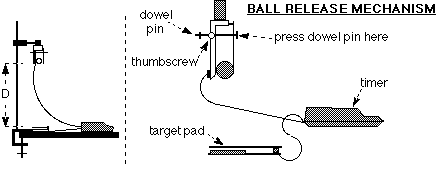

V initial is the flashlight’s velocity just before it’s dropped, or 0 m/s V final is the velocity of the light at the end of the drop. Here’s an example using our data (see the table above): If your flashlight leaves a streak of light, only record the location at the bottom of the streak (the streak is a 1/30 th of a second record of the light's fall).Ĭalculate the acceleration due to gravityĪcceleration describes how fast the rate of something changes.Īcceleration = ( V final – V initial) / the time to make this change Notice that, during the first few steps, the flashlight doesn’t fall very much. Now, step by step, record the distance in meters dropped and the corresponding time of the flashlight’s fall. The frame you’re now at is time 0s and distance 0m.) (Note that frame-by-frame players usually let you move forward or backward via arrow keys. That means each frame will add an additional 0.033 seconds.ĭistance Data: In your video player, find the frame just before your flashlight drops. Time Data: Since your camera records 30 frames a second, each frame represents only 1/30 of a second, or about 0.033 seconds. Label the columns “Time in seconds” and “Distance in meters.” (See the sample table below.) Make a table with two columns to record your data. Redo it if you didn’t get a clear view of your flashlight’s light falling straight down.

Digital video is easy to erase and reshoot. Have someone else film the drop with a digital camera (in HD at standard 30 frames per second).Ĭheck your video to make sure you got the shot. If possible, use only one finger to hold the flashlight still until the time of release. Place the light as close to the 0 cm mark as possible and against the measuring tape. Make sure your flashlight is on a non-blinking setting. Turn on the flashlight and point it upwards. The ball is not performing a simple harmonic motion, as the acceleration is not proportional to the displacement from an equilibrium position.Have one partner stand next to the measuring tape. This causes the amplitude of the height to reduce over time and eventually come to a stop due to friction forces like air resistance, which are assumed to be zero in an ideal scenario. In reality, the ball experiences damping, where it loses potential energy and kinetic energy as it falls. it seems the ball is experiencing an oscillatory motion. These stages are continuously repeated and shown in the sequence below. The last stage is the point at which the ball has reached its maximum displacement, decelerates, and changes the direction of motion from upwards to downwards. The third stage is the point at which the ball is momentarily deformed, and bounces off the ground in an upward direction until it reaches its maximum height. The second stage is the point at which the ball decelerates, changes direction once it has reached the peak point, and starts falling to the ground. It travels upwards towards its highest point. The first stage is where the ball bounces from the surface of the ground. The positive and negative directions must be stated in each example. When the ball travels in the negative direction (downwards), the velocity can be assumed to be negative. As a general rule, when the ball is travelling in the positive direction (upwards), the velocity can be assumed to be positive. The motion of the ball can be split into different stages depending on the direction of the velocity vector these stages are listed below. Hence, the only force acting on the ball is gravity. In the bouncing ball example, external forces such as air resistance are assumed to be zero. While a value of 1 indicates a perfectly elastic collision, a value of 0 indicates a perfectly inelastic collision. The coefficient of restitution is the ratio of the final to initial speed between two bodies after the collision. Total Internal Reflection in Optical Fibre.Newton’s and Huygens’ Theories of Light.Einstein's Theory of Special Relativity.Centripetal Acceleration and Centripetal Force.Electromagnetic Radiation and Quantum Phenomena.

Galileo's Leaning Tower of Pisa Experiment.Magnetic Flux and Magnetic Flux Linkage.Potential Energy and Energy Conservation.Conservative and Non Conservative Forces.


 0 kommentar(er)
0 kommentar(er)
